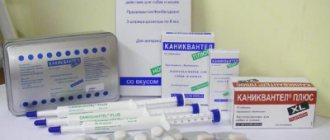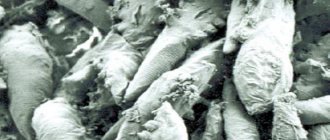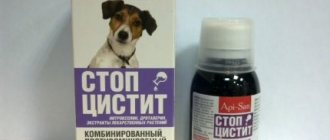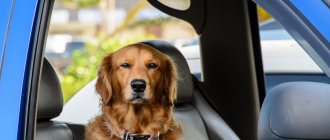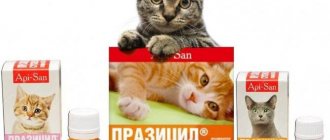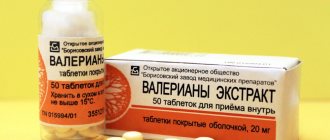Despite its reasonable safety, it is prescribed only after a veterinary examination; in case of an overdose, a slowdown in heart rate occurs. When given as injections, it relieves pain in 5-15 minutes; when taken in tablets, it relieves the animal’s condition in 30-45 minutes. No-spa is contraindicated in cases of severe renal and liver failure; it should be administered with caution to puppies, pregnant and lactating females.
Description
No-Spa is a popular antispasmodic that can be used alone or in combination with other medications. The drug is widely used in the treatment of domestic animals.
The drug is aimed at reducing muscle tone in the gastrointestinal tract, genitourinary system, biliary tract, promotes dilation of blood vessels and normalizes blood circulation.
Due to its effect on smooth muscles, it helps relieve painful spasms and improve the condition of the animal.
No-shpu is used in the following cases:
- colitis;
- urolithiasis disease;
- renal colic;
- cystitis;
- cholecystitis;
- stomach ulcer;
- constipation;
- complications after surgery;
- increased uterine tone in pregnant animals.
Important! The drug does not affect the functioning of organs, does not accumulate in the kidneys and liver and does not affect the central nervous system. The drug is available in the form of film-coated tablets or solutions intended for injection.
Analogues of the drug
An exact analogue of No-shpa is Drotaverine; Papaverine has a similar effect. If necessary, the veterinarian may prescribe other drugs with an antispasmodic effect:
- Spasmalin,
- Spasmopharm,
- Spazgan,
- Trinalgin,
- Spasmalgon,
- Maxigan,
- I took it.
We recommend reading about when to give Baralgin to your dog. From the article you will learn about the characteristics of the drug, indications for use, dosage in injections and tablets, analogues. And here is more information about whether and when you can give your dog Paracetamol.
No-spa is prescribed to dogs for pain and spasm of smooth muscles of blood vessels, urinary, biliary tract, and gastrointestinal tract. It is used in tablets for chronic diseases, but during an attack, an injection into the withers, thigh or intravenous administration of the drug is recommended.
When do you need No-spa for dogs?
No-spa for dogs is prescribed if necessary to relieve pain due to spasms of smooth muscles of the stomach, intestines, urinary and biliary tract, and vascular walls. It is needed when:
- stones in the gall bladder, kidneys (attacks of biliary and renal colic) to restore the outflow of bile or urine;
- inflammation of the intestines (colitis, enteritis), biliary tract (cholangitis) and bladder (cholecystitis), bladder (cystitis), kidneys (pyelitis) to reduce pain;
- ulcers of the stomach, duodenum or intestines (relieves pain and spasms);
- spastic constipation to facilitate bowel movements;
- increased tone of the uterus in pregnant females (prevents interruption of pregnancy);
- complications after surgery in combination with other painkillers;
- carrying out diagnostic procedures to prevent spasm of smooth muscles (for example, when examining the stomach with an endoscope).
How to help with epilepsy
No-spa for epilepsy helps relieve spasm of the arteries and improve blood flow to the affected part of the brain tissue. Sometimes a veterinarian may recommend it if a seizure occurs due to high blood pressure. The drug does not have a direct anticonvulsant effect, so for epileptic seizures it is always prescribed with other medications.
Why is it given when vomiting?
No-shpa for vomiting is administered in injections along with Cerucal (antiemetic), vitamins and glucose in order to relieve spasms of the stomach and intestines and stop increased peristalsis (contraction of the walls). It is important that the animal is examined by a veterinarian before injections, since suppressing vomiting is dangerous if the dog has swallowed a foreign object.
We recommend reading about the dosage in which Analgin can be used for dogs. From the article you will learn about the characteristics of the drug, indications for use in a pet, side effects, use in injections and tablets.
And here is more information about what painkillers can be used in dogs.
How to quickly help with pain
No-spa begins to act within 15 minutes after an injection into the withers and 5-7 minutes when administered intravenously, and when taking pain relief pills you need to wait about 30-45 minutes. Therefore, during an acute painful attack, the drug is most often prescribed by injection, and the veterinarian recommends internal use for chronic, moderate-intensity sensations.
How and where to inject?
Intramuscularly
Injections are administered intramuscularly.
Also, in some cases, you can inject the drug into the withers, subcutaneously, in the area of the shoulder blades. This is determined by the problem at hand and is resolved by the veterinarian.
Subcutaneously at the withers
It is better to have a specialist give the injection to your four-legged friend. If this is not possible, you should adhere to the following recommendations:
- The injection should only be given into a relaxed muscle, otherwise it will hurt the animal. To do this, you can do a light massage. The paw should be slightly bent.
- There is no need to use a disinfectant. This is only required if there is inflammation.
- You should absolutely not touch the needle with your hands, otherwise you can cause an infection in the muscle.
- The solution used should be neither too cold nor too hot. The body temperature is optimal - then the animal will feel almost nothing.
- There are places on the leg where injections cannot be given. They contain nerve trunks that can cause a lot of unpleasant sensations in the animal.
Attention! It is also important to place the syringe correctly.
There is no need to pre-dilute the solution. It is recommended to use insulin syringes equipped with particularly thin needles.
Intravenously
Intravenous injections are prescribed extremely rarely, as the risk of side effects and complications is high.
No-spa: instructions for dogs, how many injections to give
According to the instructions, No-Spa is injected into dogs at the withers or intramuscularly into the thigh; in severe cases, intravenous injections are required. They are done for pain, so there is no precisely established course; the drug can be used once or, if necessary, it is administered for 5-10 days.
Intramuscularly into the thigh
No-spa can be injected intramuscularly into the thigh, but this method is used less frequently, usually when injections into the dog’s withers are not possible. The animal is placed on its side and a muzzle is put on, an assistant holds the hind paw. Before injection, you need to feel the soft muscle tissue, then an injection is given in this place using the same method as at the withers, only you do not need to gather the skin into a fold.
Intramuscular injection
Introduction from ampoules to the withers
To introduce No-shpa from an ampoule into the withers, the dog needs:
- Warm the ampoule in your hands and break off the tip, draw the required amount (1 ml per 5 kg of weight) into a syringe with a thin needle, remove excess air, put the protective cap on the needle.
- Gather the skin at the withers into a fold and hold it until the injection is completed.
- Remove the cap from the needle and point the syringe strictly perpendicular to the fold.
- Insert the needle and release the solution.
- Remove the needle.
Watch this video on how to give a dog an injection at the withers:
Intravenously
Intravenous administration of No-shpa is carried out by a veterinarian in a clinic setting. For this:
- The hair on the front or back paw is trimmed.
- The dog is fixed, the limb is clamped above the injection site so that the vein appears.
- After piercing the skin, the needle is held parallel to the surface, the piston is slightly pulled towards itself so that blood appears in it to check whether it has entered the vessel.
- Remove the tourniquet and release the solution.
Intravenous injection
No-spa for a dog: dosage
The dosage of No-shpa for a dog is calculated per 1 kg of animal weight - 4 mg/kg, so for small breeds one tablet (40 mg) is divided several times, and part of the solution is taken from an ampoule (20 mg in 1 ml). The veterinarian can reduce the dose when combining No-shpa with other drugs; in case of severe pain, an increased dosage is administered once, but under the supervision of a specialist.
Is there an overdose of injections, tablets?
If the dose is calculated incorrectly (in the case of self-administration), or if the dog accidentally takes the tablets (rarely due to the bitter taste), an overdose occurs in the form of slow heartbeat. In case of severe poisoning, conduction blockade in the heart muscle is possible, resulting in cardiac arrest and death of the animal. A slight excess of the double dose leads to nausea, vomiting, and vascular collapse (pressure drops sharply).
If large quantities of the solution are injected, then you need to immediately take the dog to the clinic. There she is given IV drips with drugs that improve heart function. In case of an overdose of tablets, you should try to induce vomiting. To do this, water is injected into the mouth through a syringe or hydrogen peroxide half diluted with water is dripped onto the root of the tongue at the rate of a teaspoon per 5 kg of weight.
Daily portion by weight
For small breeds
As a rule, tablets are prescribed for individuals weighing over 10 kg; injections are indicated for smaller dogs.
The dosage is 1 ml of solution per 10 kg of weight, no more than two injections are performed in total, respectively, the daily dosage is 1 or 2 ml. But in each individual case it is determined by the doctor individually.
For large
Tablets are recommended for large dogs. A maximum of two are prescribed at the rate of one tablet (40 mg of active substance) per 10 kg of weight. If necessary, the maximum dosage is 80 mg of the main substance or 2 ml if we are talking about injections.
How many times?
No-shpu, both in the form of tablets and in the form of injections, cannot be used on dogs more than twice a day.
How many days?
A single dose may be sufficient to relieve symptoms. If longer-term treatment is necessary, the medication can be used for several days or even months. The exact course of treatment should be determined by the doctor in each specific case.
Instructions for use of the drug
No-shpu can be given to dogs both in tablets and through injections. The format of the drug is selected based on the individual characteristics of the pet, its habits and tolerance to injections. Some animals are literally very difficult to get to eat a pill, especially in cases where they have an unpleasant previous experience in their memory.
In general, the following recommendations exist:
If the animal’s weight exceeds 10 kg, then it is best to give tablets so as not to further injure the pet.
For small dogs, it is best to inject into the muscle, and under certain conditions, under the skin.
It is important to understand that the latter option dramatically reduces the effectiveness of the active substance.
The dosage is calculated based on the dog's weight. For every 10 kg of weight, you should use one 20 mg tablet or half a 40 mg tablet. If we are talking about injections, then it is recommended to use 1 ml of solution for this mass. If the dog weighs 2-3 kilograms, then give a quarter of a tablet from a package of 20 mg pills or 0.2-0.3 ml of an injection solution.
Follow us
Find out more about your animal's personality on our social networks
The injections are certainly more effective, and, most importantly, the active substance begins to act almost immediately, and reaches its peak within the first 25-30 minutes. With tablets everything is more complicated; time and effectiveness depend on many factors, for example, on the fullness of the stomach.
On the other hand, injections are fraught with various complications and unpleasant sensations for the animal. For this reason, they are used much less frequently than tablets.
And remember the basic rule: the exact dosage, frequency and forms of administration of the drug are determined by the veterinarian. Self-medication is always fraught with very serious consequences. Of course, there will be no lethal outcome, but there can be a lot of troubles.
Owner reviews
My Labrador has one very unpleasant habit - he picks up something on the street and quickly eats it while no one is looking. For this reason, he often experiences constipation and other digestive problems. We gave him all sorts of medications, but they turned out to be ineffective. Recently, a veterinarian advised us to buy No-shpa and give it for colic twice a day. All symptoms go away very quickly, literally in a few minutes, and an hour later the dog is running around the yard and feels quite cheerful.
My dog developed cystitis after giving birth. She began to ask to go outside more often and it was clear that she was in pain when urinating. I was treated for a long time with various drugs, but they only helped for a while and not always well. It was clear that the dog was suffering. The veterinarian prescribed No-Spa for us and we took two tablets twice a day.
We have a fairly old shepherd dog, she is already 12 years old. In principle, she does not complain about her health, but there is one problem - she was recently diagnosed with urolithiasis. Among other medications, the veterinarian advised us to regularly take No-shpu. I would like to note that this drug has really shown itself to be effective not only for spasms, but also for severe pain.
My dog started vomiting one day. She didn’t take action right away, because she chalked it up to simple food poisoning. However, the vomiting did not stop, the dog became lethargic and hid from me. I took her to the vet. It turned out that he had colitis, and he felt bad due to severe pain. The doctor prescribed No-shpa. The tablets are quite bitter, so I had to literally push them into the root of my tongue. But the dog felt better almost immediately.
Recently, we literally didn’t know what to do with anxiety. Soon after giving birth, our Dalmatian began to urinate very often and whined at the same time. It turned out that she had developed cystitis. To relieve attacks of pain, the veterinarian prescribed No-shpa in tablets. But apparently, because of the bitter taste, the dog refused to drink them.
Ksenia
Rex was operated on and prescribed No-shpa so that he would not suffer from colic from gases. The veterinarian said that this product is practically harmless for animals. They gave me two tablets a day. The dog recovered; he didn’t even have to buy other painkillers.
Maksim
This medication is not sold in animal pharmacies, but specialists in veterinary clinics use it in their practice for dogs.
Owner 1: “At home, I always have No-shpa in my personal first aid kit. When the veterinarian prescribed the drug to a Yorkshire terrier for colic, she learned that it is harmful to give it only in rare cases.
She refused injections; it was scary to give injections to a dog. Although the tablets are very bitter, I tried to put them on the root of my tongue. It started helping after the first pill.”
Owner 2: “We ran into a problem when our Labrador was vomiting. First with food, after a while with saliva and water.
The veterinarian prescribed No-Spa injections 2 times a day for 3 days and advised to switch to dry food, because... I had food poisoning. The next day it felt better."
If it gets bad
The drug has a minimum of contraindications and can be prescribed to animals of different ages and conditions.
Side effects are extremely rare. However, in some cases the following phenomena are possible:
- arrhythmia;
- a sharp decrease in pressure;
- depression of the respiratory center.
In the most severe cases, collapses were noted. Side effects mainly occur when the drug is administered intravenously, so such injections are practically not used.
Although the drug has low toxicity, it can be dangerous for dogs.
An overdose of the drug can cause nausea and vomiting, depression, loss of appetite or short-term convulsions. In this case, specific treatment is not required - usually the symptoms go away on their own after 1-2 days.
In some cases, an allergic reaction is possible. If its signs are noted, the drug is stopped. To mitigate the effect of the medication, anticholinergics can be used. They are indicated in the treatment of stomach or duodenal ulcers.
Contraindications and side effects
The drug has a low hazard class and can be prescribed to dogs of different breeds. Suitable for weakened and elderly animals; when treating pregnant and lactating bitches, veterinary supervision is required. Tablets and injections are administered to puppies with caution.
Dogs tolerate tablets and intramuscular injections better. Opinions regarding intravenous injections are divided. Some veterinarians believe that the risk is too great in this case, and unpleasant side effects may occur if the dosage is incorrect.
Dogs tolerate intramuscular injections of No-Shpa well, but it is better to avoid intravenous administration.
- a sharp drop in pressure;
- cardiac arrhythmia;
- depression of the respiratory center.
In especially severe cases, collapses were recorded. In modern veterinary medicine, intravenous injections of No-shpa are used only in extreme cases.
Despite its low toxicity, No-shpa can be dangerous for dogs. In case of an overdose of tablets, nausea, vomiting, depression, loss of appetite or short-term seizures are possible.
Indications for use
Veterinary medicine effectively uses drugs that are used in traditional medicine to treat humans. One of these drugs is the well-known No-shpa, which is an antispasmodic with myotropic action. This drug is used in veterinary medicine both for the treatment of farm animals and pets, including for the treatment of dogs. No-spa for dogs
The use of the drug is justified in the following clinical cases:
- hypertonicity of the uterus in pregnant bitches;
- colic of various etiologies;
- cholecystitis and cystitis;
- stomach ulcer;
- allergic reactions and skin itching caused by them;
- a sharp decrease in blood pressure of unknown etiology;
- constipation;
- complications after various surgical interventions;
- urolithiasis, etc.
No-spa relieves colic of various etiologies
In these, and many other cases, No-Spa can quickly and effectively solve the existing problem, both as the main therapy and as part of complex therapy, which is carried out according to certain schemes and in accordance with current protocols for the treatment of certain diseases in dogs.
No-spa is an antispasmodic that acts as a muscle relaxant, relaxing smooth muscles and thereby effectively relieving spasms and accompanying pain.
The main active ingredient underlying the Hungarian drug No-shpa is drotaverine hydrochloride.
Also, in the production process of this drug, excipients are used that make the effect of the drug even more effective and as safe as possible for the patient’s body.
No-spa effectively relieves spasms and accompanying painful sensations
The maximum concentration of the drug in the dog’s body is reached after about 3-4 hours, but a significant therapeutic effect occurs within a few minutes and the animal feels much lighter, as can be seen from its behavior.
Composition of the drug No-Shpa
On a note! No-Spa does not have the ability to accumulate in organs and tissues and is almost completely excreted from the body in the urine, without having a detrimental effect on the dog’s kidneys or liver. This is one of the reasons why this drug is widely used in both humans and dogs.
A product such as No-Shpa has two dosage forms - tablets and an injection solution. It is quite difficult to unequivocally answer the question of which dosage form is preferable for dogs.
There is an opinion that No-Spa in the form of an intramuscular injection acts faster than when taking tablets, but it is worth considering that the choice of dosage form depends largely on the clinical characteristics of a particular disease, as well as on the individual characteristics of the animal.
Some dogs do not tolerate any medication in pill form well, but do well when injected.
Release form of the drug No-Shpa
Attention! If you know about any peculiarities when taking drotaverine preparations, then you should definitely inform your doctor about this, which will help make the treatment as effective and less traumatic for the dog as possible.
No-spa is prescribed to dogs of all breeds, taking into account that their weight must exceed 10 kg, that is, to dogs of medium and large breeds.
For small dogs it is quite difficult to calculate the dosage, and therefore in veterinary practice in this case No-spa is not used, but it is recommended to use other drugs that have a similar pharmacological effect.
This drug can also be administered intravenously, but some experts consider this not advisable and quite traumatic for the dog, and therefore do not practice intravenous injections of No-shpa in veterinary practice.
Contraindications and side effects of No-shpa
It is necessary to calculate the dosage taking into account the weight of the dog at the rate of 1 tablet or 1 ml of injection solution for every 10 kg. Thus, the dosage of the product for a Labrador weighing approximately 40 kg will be 4 tablets or 4 ml of solution in one dose. No-spa is a fairly harmless drug that can be used in therapy for both older animals and pregnant and lactating bitches.
This drug should be used with caution to treat puppies and dogs weighing less than 10 kg. In other cases, the drug has virtually no contraindications and is successfully used in veterinary practice.
Analogues of the Hungarian drug No-shpa in composition and properties are:
- Drotaverine;
- Papaverine;
- Spasmalgon.
These drugs are sometimes produced in the nosological form of suppositories for rectal administration.
The drug Papaverine in the form of suppositories
Elena, 45 years old, Ekaterinburg
My Labrador has one very unpleasant habit - he picks up something on the street and quickly eats it while no one is looking. For this reason, he often experiences constipation and other digestive problems.
We gave him all sorts of medications, but they turned out to be ineffective. Recently, a veterinarian advised us to buy No-shpa and give it for colic twice a day.
All symptoms go away very quickly, literally in a few minutes, and an hour later the dog is running around the yard and feels quite cheerful.
No-spa helps with digestive problems
Stanislav, 34 years old, Saratov
The veterinarian prescribed No-Spa for us and we took two tablets twice a day. After the first day of treatment, it became noticeable that the dog was much better, peeing was less painful and she began to ask for a walk less often. A week later everything returned to normal.
https://www.youtube.com/watch?v=oMmCQM1zp9k
I did not expect such an effect, but No-shpa really works and helps very well.
No-spa helps cope with cystitis in dogs
Irina, 28 years old, Moscow
We have a fairly old shepherd dog, she is already 12 years old. In principle, she does not complain about her health, but there is one problem - she was recently diagnosed with urolithiasis. Among other medications, the veterinarian advised us to regularly take No-shpu.
An excellent product and its price is quite affordable
When the drug is administered intravenously to a dog and especially a puppy, blood pressure may decrease until collapse develops. Arrhythmia or depression of the respiratory center may occur. The drug is contraindicated in animals with hypersensitivity to its components.
No-shpa is also used with caution during pregnancy of a bitch and while feeding puppies. When treating gastric and duodenal ulcers, the drug must be used in combination with anticholinergics.
Review #1
My pug was vomiting for unknown reasons, but clearly not from food. And during the examination, the veterinarian also discovered pain in the abdominal area. We were prescribed no-shpa. Either inject 0.5 ml intramuscularly once a day, or give three-quarters of a 40 mg tablet. We didn’t inject it; they say the medicine works better this way. I’ve been giving the pills for a week now and I see that my dog is feeling much better.
Ruslana, Kyiv
Review #2
My dog suddenly started vomiting. They didn’t feed her for a day, but then immediately after eating, the vomiting continued the whole night. At the same time, the dog was not lethargic. And the chair was as usual. The vet said the symptoms were similar to cholecystitis. They immediately gave several injections into the muscle, including no-shpu.
We bring him home, and our baby becomes lethargic and his back legs pull, as if they are paralyzed. I was so scared, I called the clinic, and the doctor said it was from no-shpa. It’s just that the injection itself is painful and it will be painful for the dog to stand on its hind legs for some time. In further treatment, we switched to tablets and everything became fine. There was no vomiting or paralysis.
Yuri, Moscow
Did you like it? Share with your friends!
No-spa is an antispasmodic that acts as a muscle relaxant, relaxing smooth muscles and thereby effectively relieving spasms and accompanying pain. The main active ingredient underlying the Hungarian drug No-shpa is drotaverine hydrochloride. Also, in the production process of this drug, excipients are used that make the effect of the drug even more effective and as safe as possible for the patient’s body.
On a note! No-Spa does not have the ability to accumulate in organs and tissues and is almost completely excreted from the body in the urine, without having a detrimental effect on the dog’s kidneys or liver. This is one of the reasons why this drug is widely used in both humans and dogs.
The drug belongs to the group of medications with a low hazard class and is prescribed to any breed of dog. It can be used to treat elderly and weakened animals. Therapy with Drotaverine in females during pregnancy and lactation should be carried out under the strict supervision of a physician. This medication is also prescribed to puppies with caution.
Dogs tolerate intramuscular injections and tablets better. Intravenous injections can cause a number of adverse reactions, which may include:
- a sharp decrease in pressure;
- depression of the respiratory center;
- cardiac arrhythmia.
In some cases, collapses even occur. Because of this, in the practice of modern veterinary medicine it is advised to inject medicine into a vein only in extreme cases.
Although the drug is not highly toxic, however, an overdose of No-shpa can have very unpleasant consequences. For example, there is a possibility of vomiting and nausea, loss of appetite. There are cases of short-term convulsions and a depressed state of the animal. These symptoms do not require special treatment and disappear within two days. However, you will have to wait a little while taking the drug.
The principle of action of the drug
No-spa is an antispasmodic that acts as a muscle relaxant, relaxing smooth muscles and thereby effectively relieving spasms and accompanying pain. The main active ingredient underlying the Hungarian drug No-shpa is drotaverine hydrochloride. Also, in the production process of this drug, excipients are used that make the effect of the drug even more effective and as safe as possible for the patient’s body.
No-spa effectively relieves spasms and accompanying painful sensations
In addition to the fact that No-shpa is an effective muscle relaxant, its use is also justified for spastic pain of various origins. Many veterinarians prefer to use this particular drug, since it has a minimal number of side effects, and its effect occurs quickly, making it possible to provide the required assistance to the dog in a timely manner.
The maximum concentration of the drug in the dog’s body is reached after about 3-4 hours, but a significant therapeutic effect occurs within a few minutes and the animal feels much lighter, as can be seen from its behavior.
Composition of the drug No-Shpa
On a note! No-Spa does not have the ability to accumulate in organs and tissues and is almost completely excreted from the body in the urine, without having a detrimental effect on the dog’s kidneys or liver. This is one of the reasons why this drug is widely used in both humans and dogs.
Overdose
An overdose of No-shpa is still possible. The cat may develop symptoms such as vomiting, nausea, the previously mentioned paresis of the limbs, and foam at the mouth.
What should a caring owner do, especially if he was “lucky” and took his animal to an indifferent veterinarian who does not do his job well?
First of all, urgently call a veterinarian. There are such “animal” doctors who literally pull animals out of the other world.
And if there is a doctor, but you have to wait a long time for him, then you need to force the cat to drink. And then, when the vet comes, immediately put him on a drip.
It is better to avoid an “overdose” and strictly follow all instructions, including instructions regarding dosage.
How to give a cat no-shpa
Due to the unpleasant taste, the pet has great difficulty accepting the drug. Owners go to all sorts of tricks to “feed” their pet medicine. The most popular way is to dilute the required amount in sweetened water and let the cat drink throughout the day.
- Konstantin Ernst I threw Malakhov to hell after the broadcast about “sore joints”! He dared...
But if the cat won’t take the medicine anyway, you can gently force it to swallow the pill:
- 1. Carefully tilt your pet’s head back.
- 2. Unclench your jaw with your fingers.
- 3. Place the tablet on the roots of the tongue.
- 4. Use your hands to hold the mouth closed so that the animal does not spit out the bitter No-Shpu.
- 5. Stroke and blow into the nose to provoke a swallowing reflex.
Papaverine is often used to treat cats during the acute period of the disease. This antispasmodic is very effective and eliminates the symptoms of inflammation, which can pose a threat to the life of the pet. Instructions for using Papaverine for cats are presented in this article.
Release forms
Today, two options for producing no-shpa are relevant:
| Pills | In the form of yellow tablets with bilateral convexity. They can have a weight of 20g and 40g. The tablets are packaged in blisters for hermetically sealed storage and cardboard boxes. |
| Solution | The solution for intramuscular injection is offered in the format of a colorless liquid of 2 ml in dark ampoules of 5 pieces per package. As a rule, one box contains 10 ampoules. |
Injections
If it is impossible to give the dog a tablet, then you can inject the solution intramuscularly, preferably into the upper third of the thigh. Injections are more effective, but pet owners do them less often, so it’s best to trust your veterinarian. Important! Injections must be administered very slowly and deeply intramuscularly so that there are no consequences. The correct dosage of the drug is necessary so as not to harm the pet. Doses of tablets and solutions are calculated based on body weight.
Reference. The dose in tablets for pets is 1-3 mg per 1 kg of animal weight. In ampoules for injections - 1-3 mg per 1 kg of animal weight, intramuscularly.
Dosage forms of the drug No-Shpa
A product such as No-Shpa has two dosage forms - tablets and an injection solution. It is quite difficult to unequivocally answer the question of which dosage form is preferable for dogs. There is an opinion that No-Spa in the form of an intramuscular injection acts faster than when taking tablets, but it is worth considering that the choice of dosage form depends largely on the clinical characteristics of a particular disease, as well as on the individual characteristics of the animal. Some dogs do not tolerate any medication in pill form well, but do well when injected.
Release form of the drug No-Shpa
Attention! If you know about any peculiarities when taking drotaverine preparations, then you should definitely inform your doctor about this, which will help make the treatment as effective and less traumatic for the dog as possible.

